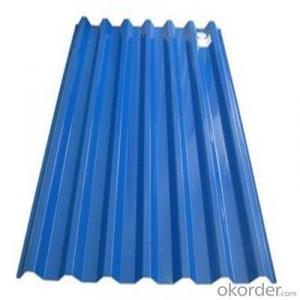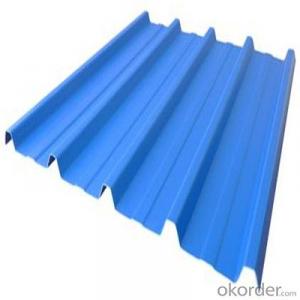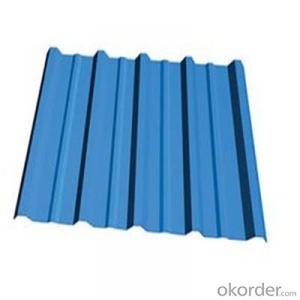Prepaint Galvanized Corrugated Iron Sheets
- Loading Port:
- Tianjin
- Payment Terms:
- TT OR LC
- Min Order Qty:
- 100 m.t.
- Supply Capability:
- 1000345 m.t./month
OKorder Service Pledge
OKorder Financial Service
You Might Also Like
Item specifice
Description of Corrugated Iron Sheet:
Minimum yield strength of 550 MPa ensures required strength for roofing application
Accurate thickness, width and length gives a perfect fit for any roof
Wider valley ensures higher water discharge in case of heavy rains
Specifications of Corrugated Iron Sheet:
Material | Steel |
Color | All RAL color |
Thickness | 0.23-1.0MM |
Width | 600mm to1200mm |
Zinc coating | 80 to 275g m2 |
Certificate | ISO 9001:2000 |
Minimum Order Quantity: | 300 Square Meter/Square Meters |
Packaging Details: | plastic film and in bundles |
Delivery Time: | within 15 days |
Supply Ability: | 30,000 Square Meter/Square Meters per day |
Features of Corrugated Iron Sheet:
Raw material width 762mm, after corrugated width 665mm: 9 waves.
Raw material width 914mm ,after corrugated width 800mm:11 waves.
Raw material width 1000mm, after corrugated 890mm or 900mm :12 or 14 waves. as customer requirement
Images of Corrugated Iron Sheet:

FAQ:
1. What's the Delivery port?
The main ports are Qingdao and Tianjin, we also can deliver to other ports to meet your requirements
2. How long is the lead time?
Delivery time: 45 days after order confirmed.
3. What payment term do you accept?
Payment: T/T or L/C at sight.
- Q:Are the steel sheets magnetic?
- Yes, steel sheets are magnetic.
- Q:Are steel sheets suitable for electrical grounding applications?
- Yes, steel sheets are suitable for electrical grounding applications. Steel is a good conductor of electricity and can effectively dissipate any electrical charges, making it an ideal material for grounding purposes.
- Q:Can steel sheets be laminated with other materials?
- Yes, steel sheets can be laminated with other materials. Lamination is a process of bonding two or more materials together to create a composite material with enhanced properties. In the case of steel sheets, they can be laminated with other materials such as plastics, polymers, wood, or even other metals. This process is commonly used to improve the strength, durability, corrosion resistance, or aesthetic appearance of steel sheets. Laminated steel sheets can be found in various industries, including automotive, construction, aerospace, and furniture manufacturing.
- Q:How do steel sheets perform in extreme temperatures?
- Steel sheets have excellent performance in extreme temperatures. Steel is known for its high strength and durability, which allows it to withstand both extremely hot and extremely cold conditions. In high temperatures, steel sheets maintain their structural integrity and do not deform or melt. Similarly, in cold temperatures, steel does not become brittle or lose its strength. This makes steel sheets a reliable choice for various applications in extreme temperature environments.
- Q:What are the different grades of steel used for manufacturing sheets?
- Steel sheets used in manufacturing come in various grades, each with its own unique properties and uses. Some commonly utilized grades include: 1. Mild Steel: This grade, also referred to as low carbon steel, is the most commonly employed for sheet manufacturing. It has a low carbon content, making it affordable and easy to work with. Mild steel sheets find application in construction, automotive manufacturing, and general fabrication. 2. High-strength Low-alloy (HSLA) Steel: Offering greater strength and improved corrosion resistance compared to mild steel, HSLA steel sheets are widely used in heavy machinery, transportation equipment, and critical structural applications. 3. Galvanized Steel: These sheets are coated with a layer of zinc, providing exceptional resistance to corrosion. Galvanized steel sheets are frequently employed in outdoor applications like roofing, siding, and automotive parts. 4. Stainless Steel: Renowned for its resistance to corrosion and staining, stainless steel sheets are suitable for a wide range of applications. They are commonly used in food processing equipment, medical devices, and architectural components. 5. Tool Steel: Tool steel sheets are specially crafted to possess high hardness, wear resistance, and toughness. They are utilized in the manufacturing of cutting tools, dies, and molds. These examples represent just a fraction of the diverse grades of steel used in sheet manufacturing. The choice of grade depends on specific requirements such as strength, corrosion resistance, and cost.
- Q:Are steel sheets non-magnetic?
- No, steel sheets are generally magnetic.
- Q:Can steel sheets be used in corrosive environments?
- Yes, steel sheets can be used in corrosive environments, but the type of steel used and the proper protective measures need to be taken into consideration. Stainless steel, for example, is highly resistant to corrosion and can withstand harsh environments. It contains chromium, which forms a protective oxide layer on the surface, preventing corrosion. Galvanized steel is another option, where a layer of zinc is applied to the steel surface, providing a protective barrier against corrosion. Additionally, various coatings such as epoxy, polyurethane, or paint can be applied to steel sheets to enhance their resistance to corrosive elements. It is important to select the appropriate steel grade and protective coatings based on the specific corrosive environment to ensure long-lasting performance. Regular inspections and maintenance are also necessary to identify and address any potential signs of corrosion.
- Q:How are steel sheets tested for quality?
- To ensure compliance with required standards, various methods are employed to test the quality of steel sheets. Among these methods, the tensile strength test is commonly used. This test gauges the steel sheet's ability to withstand stress before breaking, thus determining its durability and reliability in different applications. Another significant test is the hardness test, which measures the steel sheet's resistance to indentation or scratching. Specialized tools like Brinell or Rockwell hardness testers are utilized for this purpose. The hardness test aids in assessing the steel sheet's capacity to endure wear and tear, making it suitable for specific applications. The thickness of the steel sheet is also examined using a micrometer or ultrasonic thickness gauge to ensure it meets the necessary specifications. This is crucial as the thickness directly impacts the sheet's strength and ability to withstand external forces. Furthermore, visual inspection is carried out by trained professionals to identify any surface defects such as cracks, pits, or corrosion. Through meticulous examination, any irregularities compromising the steel sheet's quality can be detected. Chemical composition analysis is another pivotal test that determines the presence and proportion of various elements in the steel sheet. Spectrometry or X-ray fluorescence techniques are employed to ensure the steel sheet meets the desired chemical requirements. Moreover, steel sheets may undergo additional tests such as impact testing, bend testing, and fatigue testing to evaluate their performance under specific conditions. These tests replicate real-world scenarios and assess the steel sheet's ability to withstand anticipated loads and stresses. In conclusion, steel sheets are subjected to rigorous quality testing to meet the necessary standards and provide customers with reliable and durable products. These tests enable manufacturers to identify potential flaws or defects, allowing them to rectify any issues and deliver high-quality steel sheets to the market.
- Q:What is the maximum size of steel sheets available?
- The maximum size of steel sheets available can vary depending on the manufacturer and specific requirements, but generally, they can reach dimensions of up to 12 feet in width and 40 feet in length.
- Q:Can steel sheets be used in electrical applications?
- Yes, steel sheets can be used in electrical applications. They are commonly used as magnetic cores in transformers and other electrical machines. Additionally, steel sheets are often used as a protective casing or enclosure for electrical equipment.
1. Manufacturer Overview |
|
|---|---|
| Location | |
| Year Established | |
| Annual Output Value | |
| Main Markets | |
| Company Certifications | |
2. Manufacturer Certificates |
|
|---|---|
| a) Certification Name | |
| Range | |
| Reference | |
| Validity Period | |
3. Manufacturer Capability |
|
|---|---|
| a)Trade Capacity | |
| Nearest Port | |
| Export Percentage | |
| No.of Employees in Trade Department | |
| Language Spoken: | |
| b)Factory Information | |
| Factory Size: | |
| No. of Production Lines | |
| Contract Manufacturing | |
| Product Price Range | |
Send your message to us
Prepaint Galvanized Corrugated Iron Sheets
- Loading Port:
- Tianjin
- Payment Terms:
- TT OR LC
- Min Order Qty:
- 100 m.t.
- Supply Capability:
- 1000345 m.t./month
OKorder Service Pledge
OKorder Financial Service
Similar products
New products
Hot products
Related keywords






























